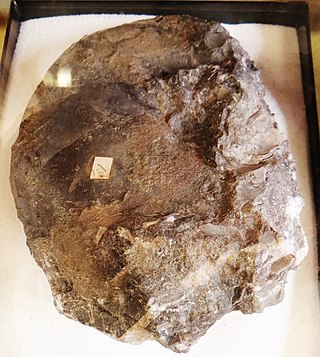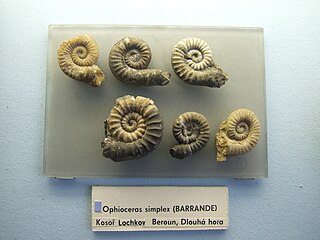Related Research Articles

The Tarphycerida were the first of the coiled cephalopods, found in marine sediments from the Lower Ordovician to the Middle Devonian. Some, such as Aphetoceras and Estonioceras, are loosely coiled and gyroconic; others, such as Campbelloceras, Tarphyceras, and Trocholites, are tightly coiled, but evolute with all whorls showing. The body chamber of tarphycerids is typically long and tubular, as much as half the length of the containing whorl in most, greater than in the Silurian Ophidioceratidae. The Tarphycerida evolved from the elongated, compressed, exogastric Bassleroceratidae, probably Bassleroceras, around the end of the Gasconadian through forms like Aphetoceras. Close coiling developed rather quickly, and both gyroconic and evolute forms are found in the early middle Canadian.
The Tarphyceratidae are tightly coiled, evolute Tarphycerida with ventral siphuncles. The dorsum is characteristically impressed where the whorl presses against the venter of the previous. The Tarphyceratidae are derived from Bassleroceras or possibly from some member of the Estonioceratidae.
Bickmorites is an extinct nautiloid cephalopod genus known from the upper Ordovician to the middle Silurian of North America and northern Europe (Norway).
Uranoceras is a barrandeocerid genus from the Middle Silurian belonging to the family Uranoceratidae, characterized by its loosely coiled, gyroconic shell of 1.5 to 2 subquadrate whorls.
Basslerocerida is an order of nautiloid cephalopods from the Ordovician comprising exogastric longiconic cyrtocones, that is no longer in common use.

The Trigonoceratoidea are a superfamily within the Nautilida that ranged from the Devonian to the Triassic, thought to have contained the source for the Nautilaceae in which Nautilus is found.
The Graciloceratidae is a family of nautiloid cephalopods from the Middle and Upper Ordovician belonging to the Oncocerida, characterized by exogastric cyrtocones that expand slightly or moderately and have thin walled, orthochoanitic marginal or subventral, tubular siphuncles.

The Phragmoceratidae is a family of extinct nautiloid cephalopods from the Order Discosorida that lived during the latter part of the Silurian.
The Naedyceras group comprises three similar and closely related openly coiled, gyroconic, genera within oncocerid family, Brevicoceratidae: Naedyceras, Gonionaedyceras, and Gyronaedyceras.
Laureloceras is a genus of the tarphycerid family Plectoceratidae that lived during the Middle Silurian in what is now North America.

The Barrandeoceratidae is a family of coiled nautiloids included in the Tarphycerida that lived from the Middle Ordovician to the Middle Devonian, characterised by mostly compressed shells with a subcentral siphuncle composed of thin-walled segments that may become secondarily ventral.(Flower and Kummel 1950, Sweet 1964).

Ophioceras is a genus of closely coiled tarphycerid nautiloid cephalopods, the sole representatives of the family Ophidioceratidae, characterized by an evolute shell with narrow, subrounded, annulated whorls and a subcentral siphuncle composed of thin connecting rings that show no evidence of layering. The mature body chamber is strongly divergent and is the longest proportionally of any tarphycerid. The aperture has a deep hyponomic sinus and ocular sinuses, and so resembles some lituitids.
The Barrandeocerina comprise a suborder of Early Paleozoic nautiloid cephalopods, primitively coiled but later forms may be cyrtoconic, gyroconic, torticonic, and even breviconic, all having empty siphuncles with thin connecting rings. The Barrandeocerina were originally defined as a separate order by Rousseau Flower, but since then have been united within the Tarphycerida as a suborder. Derivation is from the Tarphyceratidae.
Chidleyenoceras is a Middle Ordovician tarphyceroid with a closely coiled, evolute shell; whorl section subquadrate, widest just above a broadly rounded venter; dorsum with a broad shallow impression; sutures moderately spaced, weakly sinuous; siphuncle large, subventral, apparently orthochoantitic with tubular segments.
The Apsidoceratidae is a family of Middle and Upper Ordovician Barrandeocerina,, characterized by curved or coiled, smooth, transversely marked, or laterally costate shells, with a conspicuous hyponomic sinus. Early whorl sections tend to be subtriangular; become broader and dorsally impressed in closely coiled forms. Sutures are with lateral lobes in primitive forms but are without lateral lobes, but with ventral lobes in more advanced species with broader sections. Siphuncles are between the center and ventral margin, but not close to either.

Barrandeoceras is a large, coiled, Middle Ordovician nautiloid cephalopod and part of the Tarphycerida. The shell is serpenticonic with whorls touching but not embracing. The adult body chamber becomes freed of the preceding whorl, a rather common character among tarphycerids. Whorl section is oval, somewhat more narrowly rounded ventrally, on the outer rim, than dorsally, on the inner rim. Prominent lateral ribs, at least on inner whorls. Grow lines show a distinct hyponomic sinus. Sutures have lateral lobes. The siphuncle is subcentral.
Plectoceras is a genus of nautiloids included in the tarphycerid suborder Barrandeocerina that lived during the Middle and Late Ordovician. It has been found widespread in the Middle and Upper Ordovician of North America.

Domatoceras is a nautiloid genus and member of the Grypoceratidae from the Pennsylvanian and Permian with a wide spread distribution.
Haydenoceras is a genus of middle Devonian cephalopods originally placed in the Barrandeocerida. The genus can be recognized by its strongly compressed, gradually expanding exogastrically curved shell with a strongly rounded dorsum and acutely angled venter, calling attention to the general form of earlier Bassleroceras. The siphuncle is tubular, central.
Charactoceras is a tarphycerid genus cephalopod which lived during the Late Ordovician.
References
- Rousseau H. Flower, 1984. Bodeiceras; a New Mohawkian Oxycone, with Revision of the Older Barrandeocerida and Discussion of the Status of the Order. Journal of Paleontology v. 58, no.6, pp 1372–1379, Nov. 1984.
- Walter C Sweet, 1964 Nautiloidea-Barrandeocerida; Treatise on Invertebrate Paleontology, Part K Mollusca 3. Geological Society of America and University of Kansas Press.